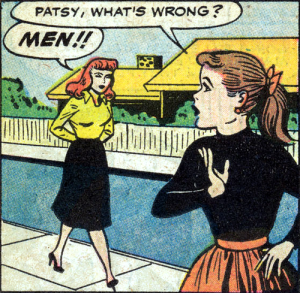Feminism is a multifaceted movement advocating for the social, political, and economic equality of all genders. However, an irritating misconception persists that links feminism with misandry—the dislike or contempt for men. This reductionist interpretation oversimplifies the nuanced goals of feminist thought and practice. Understanding this distinction requires not only a historical examination of feminist movements but also a critical analysis of cultural narratives perpetuated around gender. Central to this discussion is the need to disentangle feminism from the misconstrued notion that it encourages the hatred of men.
The Roots of Feminism: A Historical Perspective
Feminism has evolved through several waves, each characterized by distinct goals and societal contexts. Typically delineated into first, second, and third waves, these phases converge in their objective to challenge patriarchal structures and advocate for women’s rights.
First Wave Feminism emerged in the late 19th and early 20th centuries, primarily focusing on legal inequalities, such as suffrage. Activists like Susan B. Anthony and Elizabeth Cady Stanton campaigned for women’s right to vote, which they posited was vital to achieving broader equality. This wave was predominantly concerned with civic rights and social recognition rather than antagonism towards men.
Second Wave Feminism, flourishing in the 1960s and 70s, expanded its focus to include workplace rights, reproductive rights, and sexual liberation. Figures such as Betty Friedan and Gloria Steinem emphasized systemic inequality, illustrating how societal norms perpetuated female subservience. Again, throughout this period, feminism sought to uplift women, not diminish men.
Modern feminism, or Third Wave Feminism, incorporates diverse perspectives and recognizes intersectionality—a concept coined by Kimberlé Crenshaw. This framework analyzes how different social identities (race, class, sexuality) intersect with gender, reinforcing the understanding that feminist struggles are multifaceted and cannot be boiled down to a singular animus against men. Rather, contemporary feminism advocates for global equity and seeks to disrupt oppressive systems widely, using a variety of tools and methods, from activism to art.
Misandry: Distorted Perceptions of Feminism
Misandry is often mistakenly conflated with feminism by skeptics and detractors who view the feminist critique of patriarchy as inherently antagonistic toward men. This perspective neglects the underlying principles of feminism, which aim to deconstruct systems of power that beget inequality regardless of gender. Misandry, in its true sense, suggests a blanket disdain for men, which contradicts the fundamental premise of feminism that seeks not only liberation for women but for all marginalized individuals. Yet, this misconception prevails in certain cultural narratives, often fueled by sensationalist media and polarized social discourse.
The Role of Media and Popular Culture
Media representation plays a significant role in shaping public perception of feminism and its goals. In popular culture, portrayals of feminists are often exaggerated or reductive, presenting an oversimplified caricature of the movement. Notable is the trope of the “man-hating feminist” showcased in various media formats, from comic relief in television shows to vilification in mainstream news outlets. Such representations can skew the public’s understanding of feminism, reinforcing misconceptions that feminists harbor an irrational animosity towards men.
Additionally, social media platforms, while enabling feminist discourse to proliferate, can sometimes engender hostility. The anonymity and immediacy granted by these platforms can lead to extreme viewpoints being amplified, giving rise to misandric sentiments among fringe groups. Consequently, these expressions, while not representative of mainstream feminist ideologies, can contribute to the mischaracterization of feminism itself, erroneously suggesting that its adherents espouse hate against men.
Internal Conflicts and Misconceptions
Within the feminist movement, there exist divergent views and discussions about the male experience in a patriarchal context. Some feminists argue that men must take responsibility for systemic oppression and actively participate in dismantling patriarchal structures. This perspective can, regrettably, be interpreted as blaming men for societal issues, leading to accusations of misandry. On the other hand, many feminists assert that the goal is not to vilify men but to foster solidarity in the collective pursuit of gender equality.
Moreover, the discourse on toxic masculinity, which critiques societal norms dictating male behavior, is often misconstrued as devoting animus toward all men. While it seeks to illuminate how constricting definitions of masculinity harm not only women but men as well, such discussions can foster defensive reactions among some men, resulting in a backlash against feminist thought. This reaction further complicates the dialogue, leading to a cyclical misunderstanding where feminism is falsely equated with misogyny towards men.
Unpacking the Misunderstanding: The Feminist Call for Equity
Ultimately, the conflation of feminism with misandry reflects broader societal tensions surrounding gender discourses. Feminism insists upon equality, contending that by uplifting women, society benefits as a whole. This urgent call for equity is not an indictment of men but rather a challenge to systemic inequality that restricts human potential across the gender spectrum.
Importantly, many feminist activists emphasize collaborative efforts with men as allies rather than adversaries. Encouraging men’s engagement in feminist causes aids in eradicating misconceptions, including worries about misandry. It is essential for dialogues surrounding masculinity and femininity to navigate compassionately while acknowledging the systemic entrenchments that perpetuate gender-based disparities.
Conclusion: Toward a More Nuanced Understanding
Understanding feminism necessitates nuanced discourse that transcends the binary of men versus women. By recognizing that feminism is primarily an advocacy for equality and social justice, freer from biases and resentment, one can appreciate its holistic vision. Misandry and its conflation with feminist ideologies are largely social constructs rather than reflections of feminist thought. As dialogues evolve and gender narratives shift, it is crucial to foster understanding, inclusivity, and shared responsibility within this ongoing struggle for equality—welcoming all genders to dismantle oppressive systems collaboratively. In this regard, the empowerment of all individuals, irrespective of gender, remains central to the feminist mission.





























